Automatic Management and Monitoring of Bridge Lifting: A Method of Changing Engineering in Real-Time
Abstract
:1. Introduction
2. Introduction to the Method
2.1. Method of Changing the Bottom of the Wuxi Bridge on Provincial Highway 3
2.2. Introduction of Wuxi Bridge’s Bottoming Method
2.3. Structure Analysis (Computer Software Tools SAP2000)
2.4. Application of Monitoring System
3. Local Experiment
3.1. Experimental Planning
3.1.1. Microseismic Measurement Experiment
3.1.2. Strain Measurement Experiment
3.1.3. Measured Value
3.2. Instrument Planning
3.3. Measurement Method and Instrument Description
3.3.1. Subsidence Meter
3.3.2. Tilt Meter
4. Theoretical Analysis
4.1. Static Analysis Process
4.2. Power Analysis Process
4.3. Determination of Management Values
4.4. Bridge Structure Simulation and Vibration (Mode) State Analysis Results
5. Monitoring System
System Architecture
- Data conversion and storage function: The system automatically calls the sensor to obtain the sensing data according to the set value and writes the corresponding data table according to the different types of sensors, where the written information includes the sensor number, data time, sensing data, and data status.
- Authority management and maintenance function module:
- (1)
- Add account: This allows the application interface on the homepage to add the user’s account, including the account number, password, unit, name, mobile phone, and other information.
- (2)
- Account maintenance: Users can modify the data in their own account, but the account cannot be modified, and the modification level must be modified by the system administrator.
- (3)
- Privilege Control: For the inquiry account interface, this is used for the account verification function and the account level setting function, which can set the level of the account and also delete the account data.
- (4)
- Login system function: This provides the account password login function on the homepage, compares the account passwords sent to enter the system, and provides the “forgot password” function in which the user enters their account number and email address. If the match is met, the system will send the password to the email address and provide system functions according to the authority set.
- Monitoring point management function
- (1)
- Function entry: Monitoring point management.
- (2)
- Query interface: This provides the bridge pier number and instrument category query conditions, and it also provides the new, modify, delete, print (Excel) functions, where the system administrators and data maintainers can edit and delete data, and the system automatically records and edits personnel. When deleting the data, the system will display a confirmation window for the user to confirm, and the device can be deleted if are is no data in the instrument. After confirming the deletion, the “data deleted” dialog box will be displayed, as shown in Figure 29.
- (3)
- New monitoring point data: This is used to distinguish between automatic measuring points and manual measuring points, as well as adding monitoring point data, including the bridge pier number, measuring point number, measuring point type, sensor number, and other data. When the new measurement point number is added, the existing number will be automatically avoided, and the recommendation number will be automatically displayed. The suggested number is modifiable. After the confirmation number is sent, the system will automatically generate the identification number (SID, System Identification) and conduct an automatic check. Whether the measuring point SID is repeated, if it is repeated, it returns to the editing screen and is marked with a red word after the repeated data. If it is an automatic monitoring point, the system checks whether the signal channel was repeated. If it was repeated, the system will return to the editing screen and it will be marked with a red word after the repeated data. When the data are written into the database after it has been checked, the dialog box “The data has been added” will be displayed. If it is a manual monitoring point, there is no need to fill in the signal channel, as shown in Figure 30.
- (4)
- Monitoring point data maintenance: After clicking the measuring point number in the query list, the editing interface icon will be opened, which is the same as the new interface graphic structure; however, the pier number, measuring point category, and measuring point number are not modifiable. When the data are written to the database through the check, the dialog box “Data has been modified” will be displayed. This function also provides the function of deleting the monitoring point data, although the monitoring point cannot be deleted if the sensor data has been received or the observation data has been reported.
- Manually report the monitoring data maintenance function module:
- (1)
- Function entry: Manual monitoring and maintenance.
- (2)
- Data inquiry: After clicking the bridge pier number, the system will automatically enter the manual measurement point number. In the time interval, a small calendar will be provided for selection. If the time is not selected, it will represent the whole day. When a date is specified, it will only check the data for that day. In addition, when the “normal value” is checked, the normal value data will be displayed; if the “exceeding the warning value” is checked, the data exceeding the warning value will be displayed; and if the “exceeding the action value” is selected, the data exceeding the action value will be displayed. For all three, the user selects at least one option to check. When the user clicks “Query”, a list of information will be displayed. When they click the new icon, the “Add” window will open. The query list is printable. After selecting the measurement point number, the system will automatically display it, providing a description of the measurement point.
- (3)
- New monitoring data: When using the supervision unit and the bridge name number, these will be automatically displayed, along with the other pier number selections, measuring point selection, observation time, observation data, reporting personnel, and reporting time. When selecting the measuring point number, the system will automatically display the description information of the measurement point.
- (4)
- Monitoring data maintenance module: When clicking the editing icon of the measuring point number in the query list, the editing interface will be opened, which is basically the same as the new interface, only that the time and value are allowed to be modified, whilst the pier number and the point number are not modifiable. After the data are written into the database, it will display the “Data has been modified” dialog box, and the system will automatically record the modified personnel. In addition, this function also provides the function of deleting single monitoring data. When deleting, the system will automatically record the personnel and time of deleting the data.
- Warning value management function module:
- (1)
- Function entry: Alert value management.
- (2)
- Warning value interface module: The supervisory unit and bridge name number will be displayed automatically when using the module, and it will provide the UI (User Interface) of the sinker, the tilt meter alarm value, and the action value input, as shown in Figure 31. The default mode of the alert mode is to check the send SMS option, and unchecking will not send the SMS. If the setting is enabled, the default value is ticked. When the alarm value is changed, the system will display the dialog box “The status of all monitoring data will be re-determined, whether the change is confirmed”. If the change is confirmed, the system will redetermine all the sensing data and redisplay the field data.
- Monitoring data query function module:
- (1)
- Function entry: Monitoring data query.
- (2)
- Seepage monitoring data query: This provides the conditions for the pier number, sensing method, measuring point number, time interval, and action warning. After selecting the conditions, the qualified information will be displayed. In addition, after clicking the bridge pier number, the system will automatically display the measurement point number. When the automatic or manual check is selected, the measurement point number will be automatically displayed. The default value is both full hooks. At least one option should be selected when using. In the time interval, a small calendar is available for selection. If the time is not selected, it means the full day. When a date is specified, it means only the day the information is checked. When the “normal value” is checked, the normal value data are displayed, and the warning is exceeded. “Value” displays the data exceeding the warning value. If the “Exceeded action value” is checked, the data exceeding the action value are displayed. The default value is fully selected. When using this, at least one option must be checked to query. When clicking “Query” to display the list of materials, while using the paging function, the output in Excel format data will be printed.
- (3)
- Tilt meter monitoring data query: This uses the monitoring data query like the sinker.
- Instant warning function module:
- (1)
- Warning resident program: For a resident in the operating system, the triggering time is as follows: after the sensing data of the module are captured regularly, the data input system function module is added to the data, and if the warning value is exceeded, the action is exceeded. The value is sent as a short message notification to the set alert object.
- Monitoring information display platform function module
- (1)
- Full-bridge monitoring information display module: This displays the full-bridge diagram of the construction scope of the provincial road “Taiwan 3 line 210k Wuxi Bridge Foundation Reconstruction Project”, including the direction and pier number. The piers included in the monitoring are marked with lights. When the bridge pier is normal, it is displayed with a green light, and when any sensor data of the pier exceed the warning value, a yellow light warning is displayed. When any sensor data of the pier exceed the action value, a red light warning is displayed, and all the sensor information is listed. The sensor information content includes the sensor name and the sensing data. The sensor data exceeding the warning value are represented by an orange indicator. The sensor data exceeding the action value are indicated in red, and the abnormal sensor data are in black. When the mouse cursor is moved to any pier, all the sensor information is displayed. Double-clicking the bridge icon opens the display module of the bridge monitoring information, as shown in Figure 32. In the illustration in Figure 32, the red warning of the P09 pier is due to P9 pier being used for the jacking project. After P09 pier is lifted, the reference value of the subsidence meter will be reset (before the bridge pier is replaced) to monitor the subsidence and inclination of the P09 pier after jacking.
- (2)
- Bridge pier monitoring information display module: This is displayed as a small picture with full bridge graphics, including direction and pier number. The bridge piers that are included in the monitoring are all displayed by lights. The bridge monitoring diagram can display three kinds of graphics: front view, side view, and plan view. The other sensors are displayed in different positions according to their types. When the sensor data bit is at a normal value, it is displayed as a green icon. When the sensor data exceed the warning value, they are displayed as a yellow icon. When the action value is exceeded, it is displayed as a red icon to inform the monitoring manager, and to inform the relevant personnel by SMS. The information of each sensor indicates that the monitor is still reminded by the color of the text. When the monitored value exceeds the warning value, the data displayed by the sensor are represented by orange text. When the monitored value exceeds the action value, the sensor displays the data in red text. When there is no abnormality in the monitored value, the data displayed by the sensor are indicated in black text. When the user double-clicks the full bridge icon, they will return to the full bridge monitoring information display module. When they double-click the sensor, the sensor monitoring information display module is turned on, as shown in Figure 33.
6. Conclusions and Recommendations
- The traditional bridge detection method has the disadvantage of not having continuity, and the value of manual timing observation easily produces errors affecting the detection results. The automatic monitoring system can greatly reduce the monitoring errors and can continuously record the sensor data. It also has an instant warning function, which is a necessary trend going forward.
- At present, most of the bridge construction monitoring in this area still uses the traditional manual timing observation and measurement as the data analysis method. When a typhoon is heavy, or the river is flooded, the artificial measurement cannot be measured and observed. However, when the typhoon is rainy, this also means the bridge is dangerous. Therefore, in order to ensure that bridge monitoring is continuous and immediate, it is recommended to adopt a scientific automatic monitoring system to match modern trends.
- In order to understand the dynamic response of the bridge and the warnings of change, various types of monitoring sensors are installed on the bridge to obtain structural response and environmental data, and long-term analysis and evaluation work should be carried out to reduce the social cost caused by a disaster. Based on the concept of bridge monitoring center information management, and with the advancement of network technology and remote control and centralized management, integrating all bridge monitoring systems to achieve effective centralized management reduces the need for managers.
- This paper establishes the finite element computer model of the bridge and sets the management values for monitoring with reference to the bridge design specifications and design data, and it compares the management values with the actual monitoring data to determine whether the preliminary monitoring management value is reasonable. Therefore, it proves that the method of setting the management value is feasible.
- Regarding the impact of bridge use and vehicle driving and the surrounding environment, the grade of the bridge vibration can be used as its performance index, where the measurement of bridge vibration is the most effective function of bridge monitoring. Reinforcement and old processing are also carried out using this method.
- The monitoring system used this study is unique (bridge replacement method). In the future, when similar engineering methods are applied, these methods can also be improved based on the monitoring method adopted in this study to improve the quality and effect of monitoring.
Author Contributions
Funding
Conflicts of Interest
References
- Xu, Y.L.; Xia, Y. Structural Health Monitoring of Long-Span Suspension Bridges; CRC Press: Boca Raton, FL, USA, 2011. [Google Scholar]
- Roberts, G.W.; Meng, X.; Dodson, A. The use of kinematic GPS and triaxial accelerometers to monitor the deflection of large bridges. In Proceedings of the 10th International Symposium on Deformation Measurement, Orange, CA, USA, 19–22 March 2001. [Google Scholar]
- Andersen, E.; Pederson, L. Structural monitoring of the Great Belt East Bridge. Symp. Strait Crossings 1994, 94, 189–195. [Google Scholar]
- Tamura, Y.; Matui, M.; Panini, L.-C.; Ishibashi, R.; Yoshida, A. Measurement of wind-induced response of buildings using RTK-GPS. J. Wind Eng. Ind. Aerodyn. 2002, 90, 1783–1793. [Google Scholar] [CrossRef]
- Sumitoro, S.; Matsui, Y.; Kono, M.; Okamoto, T.; Fujii, K. Long span bridge health monitoring system in Japan. In Proceedings of the 6th Annual International Symposium on NDE for Health Monitoring and Diagnostics, Newport Beach, CA, USA, 4–8 March 2011. [Google Scholar]
- Chan, T.H.; Yu, L.; Tam, H.Y.; Ni, Y.Q.; Liu, S.; Chung, W.; Cheng, L. Fiber bragg grating sensor for structural health monitoring of Tsing Ma Bridge: Background and experimental observation. Eng. Struct. 2006, 28, 648–659. [Google Scholar] [CrossRef]
- Wang, H.; Tao, T.; Li, A.; Zhang, Y. Structural health monitoring system for Sutong cable-stayed bridge. Smart Struct. Syst. 2016, 18, 317–334. [Google Scholar] [CrossRef]
- Zhou, G.-D.; Yi, T.-H. Recent development on wireless sensor network technology for bridge health monitoring. Math. Probl. Eng. 2013, 2013, 1–3. [Google Scholar] [CrossRef]
- Li, H.-N.; Li, D.-S.; Ren, L.; Yi, T.-H.; Jia, Z.-G.; Li, K.-P. Structural health monitoring of innovative civil engineering structures in mainland China. Struct. Monit. Maint. 2016, 3, 1–32. [Google Scholar] [CrossRef]
- Meng, X.; Roberts, G.W.; Dodson, A.; Ince, S.; Waugh, S. GNSS for structural deformation and deflection monitoring: Implementation and data analysis. In Proceedings of the 3rd IAG/12th FIG Symposium, Baden, Germany, 22–24 May 2006. [Google Scholar]
- Roberts, G.W.; Brown, C.J.; Meng, X.; Ogundipe, O.; Atkins, C.; Colford, B. Deflection and frequency monitoring of the Forth Road Bridge, Scotland, by GPS. Proc. Inst. Civ. Eng. Bridge Eng. 2012, 165, 105–123. [Google Scholar] [CrossRef]
- Meng, X.; Xie, Y.; Bhatia, P.; Sowter, A.; Psimoulis, P.; Colford, B.; Ye, J.; Skicko, M.; Dimauro, M.; Ge, M. Research and development of a pilot project using GNSS and Earth Observation (GeoSHM) for structural health monitoring of the Forth Road Bridge in Scotland. In Proceedings of the Joint International Symposium on Deformation Monitoring, Vienna, Austria, 30 March–1 April 2016. [Google Scholar]
- Meng, X.; Nguyen, D.T.; Xie, Y.; Owen, J.S.; Psimoulis, P.; Ince, S.; Chen, Q.; Ye, J.; Bhatia, P. Design and Implementation of a New System for Large Bridge Monitoring—GeoSHM. Sensors 2018, 18, 775. [Google Scholar] [CrossRef]
- Jenkins, C.H.; Kjerengtroen, L.; Oestensen, H. Sensitivity of parameter changes in structural damage detection. Shock Vib. 1997, 4, 27–37. [Google Scholar] [CrossRef]
- Jang, P.A. Videogrammetric Technique-Based Monitoring of Structural Vibration. Master’s Thesis, Zhejiang University, Hangzhou, China, 2011. [Google Scholar]
- Chang, P.C.; Flatau, A.; Liu, S.C. Review paper: Health monitoring of civil infrastructure. Struct. Health Monit. 2003, 2, 257–267. [Google Scholar] [CrossRef]
- Zhao, X.; Liu, H.; Yu, Y.; Xu, X.; Hu, W.; Li, M.; Ou, J. Bridge Displacement Monitoring Method Based on Laser Projection-Sensing Technology. Sensors 2015, 15, 8444–8463. [Google Scholar] [CrossRef]
- Lovse, J.W.; Teskey, W.F.; Lachapelle, G.; Cannon, M.E. 7-Dynamic Deformation Monitoring of Tall Structure Using GPS Technology. J. Surv. Eng. 1995, 121, 35–40. [Google Scholar] [CrossRef]
- Psimoulis, P.A.; Stiros, S.C. Measurement of deflections and of oscillation frequencies of engineering structures using robotic theodolites (RTS). Eng. Struct. 2007, 29, 3312–3324. [Google Scholar] [CrossRef]
- Zhou, J.T.; Li, X.G.; Xia, R.C.; Yang, J.; Zhang, H. Health monitoring and evaluation of long-span bridges based on sensing and data analysis: A survey. Sensors 2017, 17, 603. [Google Scholar] [CrossRef] [PubMed]
- Schumacher, T.; Shariati, A. Monitoring of structures and mechanical systems using virtual visual sensors for video analysis: Fundamental concept and proof of feasibility. Sensors 2013, 13, 16551–16564. [Google Scholar] [CrossRef]
- Palazzo, D.; Friedmann, R.; Nadal, C.; Santos, F.M.; Veiga, L.; Faggion, P. Dynamic monitoring of structures using a robotic total station. In Proceedings of the Shaping the Change XXIII FIG Congress, Munich, Germany, 8–13 October 2006. [Google Scholar]
- Park, H.S.; Lee, H.M.; Adeli, H.; Lee, I. A New Approach for Health Monitoring of Structures: Terrestrial Laser Scanning. Comput. Aided Civ. Infrastruct. Eng. 2007, 22, 19–30. [Google Scholar] [CrossRef]
- Zhang, B.; Wang, H.; Mao, C. Study on Displacement Sensor Based on Difference Operation Spot Center Location Algorithm. Chin. J. Sens. Actuators 2011, 24, 215–219. [Google Scholar]
- Andersen, E.Y. Structural monitoring of the Great Belt East Bridge. In Proceedings of the Third Symposium on Strait Crossing, Ålesund, Norway, 12–15 May 1994; A.A. Balkema: Rotterdam, The Netherlands, 1994. [Google Scholar]
- Myroll, F.; Dibiagio, E. Instrumentation for monitoring the Skarnsunder Cable-stayed Bridge. In Proceedings of the 3rd Symposium on Strait Crossing, Ålesund, Norway, 12–15 June 1994; pp. 207–215. [Google Scholar]
- Fang, Y.M.; Pu, J.P. Field tests and simulation of Lion-Head River Bridge. J. Shock Vib. Sci. 2007, 48, 181–228. [Google Scholar] [CrossRef]
- Xu, Y.L.; Zhu, L.D. Buffeting response of long-span cable-supported bridges under skew winds. Part 2 case study. J. Sound Vib. 2004, 23, 675–697. [Google Scholar] [CrossRef]
- Lahdensivu, J.; Köliö, A.; Husaini, D. Alkali-silica reaction in Southern-Finland’s bridges. J. Case Stud. Constr. Mater. 2018, 7, 469–475. [Google Scholar] [CrossRef]
- Chen, Z.; Zhou, X.; Wang, X.; Dong, L.; Qian, Y. Deployment of a smart structural health monitoring system for long-span Arch Bridges: A review and a case study. Sensors 2017, 17, 2151. [Google Scholar] [CrossRef] [PubMed]
- Xin, J.; Zhou, J.; Yang, S.X.; Li, X.; Wang, Y. Bridge Structure Deformation Prediction Based on GNSS Data Using Kalman-ARIMA-GARCH Model. Sensors 2018, 18, 298. [Google Scholar] [CrossRef] [PubMed]
- Bedon, C.; Bergamo, E.; Izzi, M.; Noè, S. Prototyping and Validation of MEMS Accelerometers for Structural Health Monitoring—The Case Study of the Pietratagliata Cable-Stayed Bridge. J. Sens. Actuator Netw. 2018, 7, 30. [Google Scholar] [CrossRef]
- Reilly, J.; Glisic, B. Identifying Time Periods of Minimal Thermal Gradient for Temperature-Driven Structural Health Monitoring. Sensors 2018, 18, 734. [Google Scholar] [CrossRef]
- Thalla, O.; Stiros, S.C. Wind-Induced Fatigue and Asymmetric Damage in a Timber Bridge. Sensors 2018, 18, 3867. [Google Scholar] [CrossRef] [Green Version]
- Highway Bridge Design Code; The Ministry of Transportation and Communications: Taipei, Taiwan, 1990. (In Chinese)
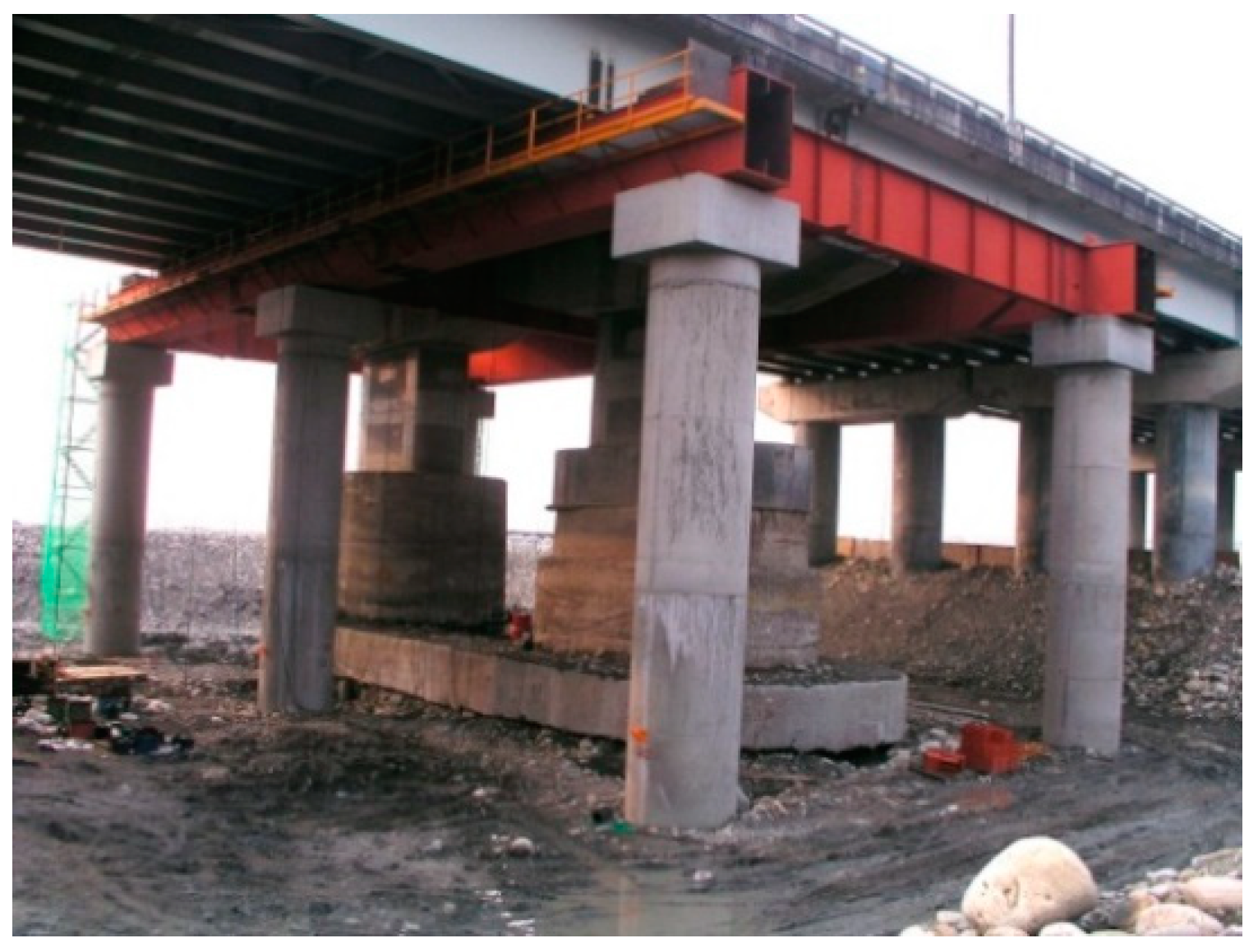




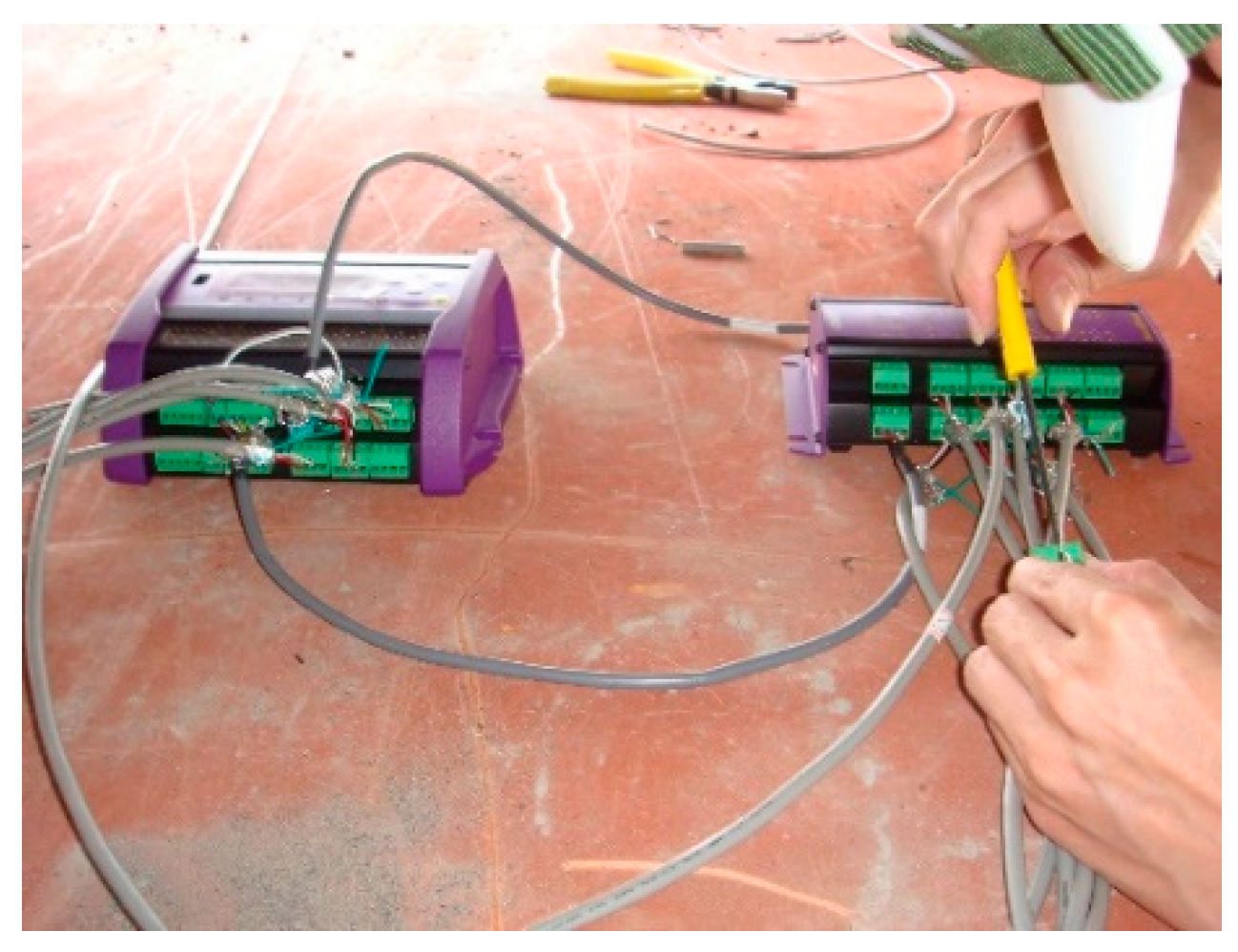


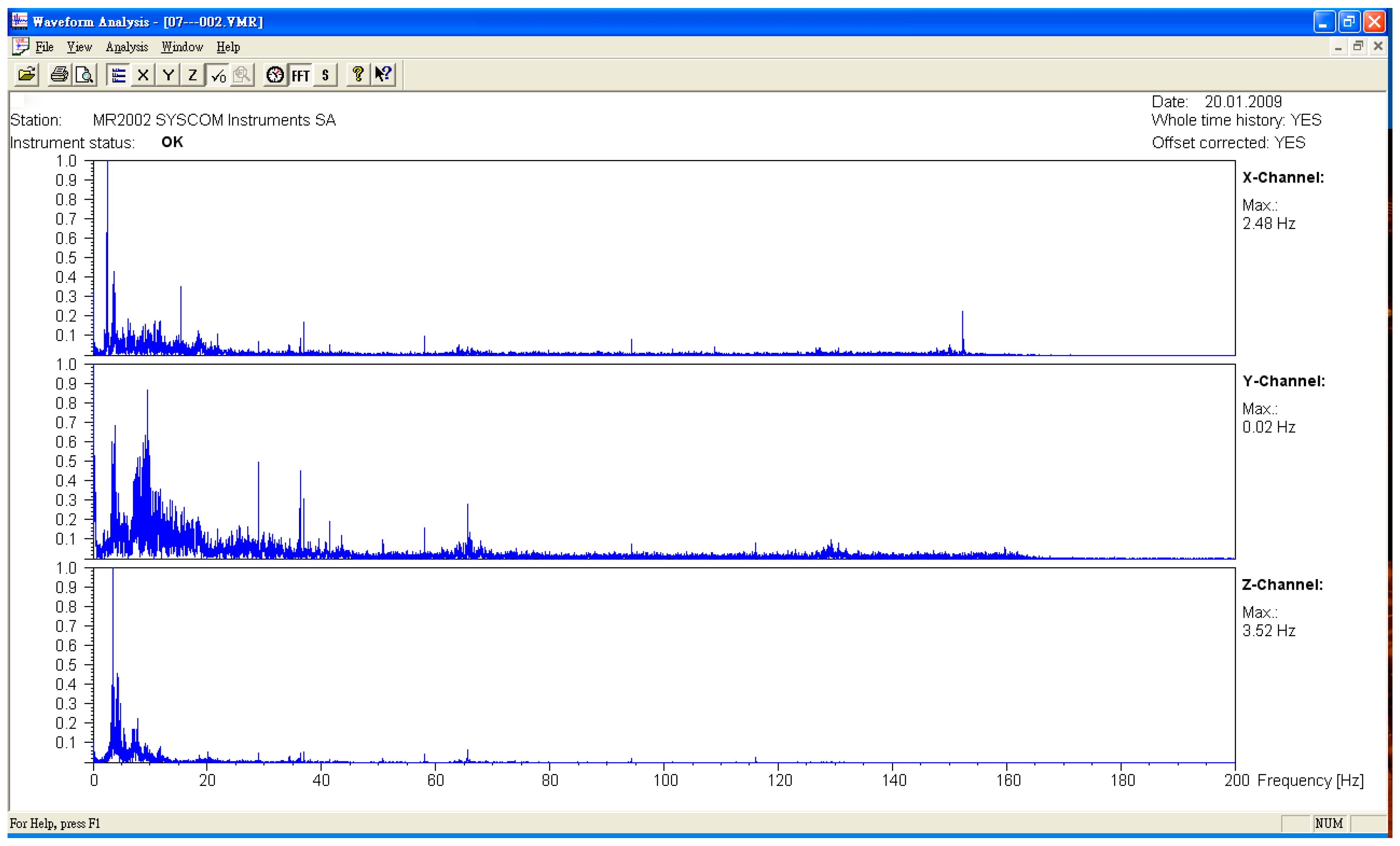
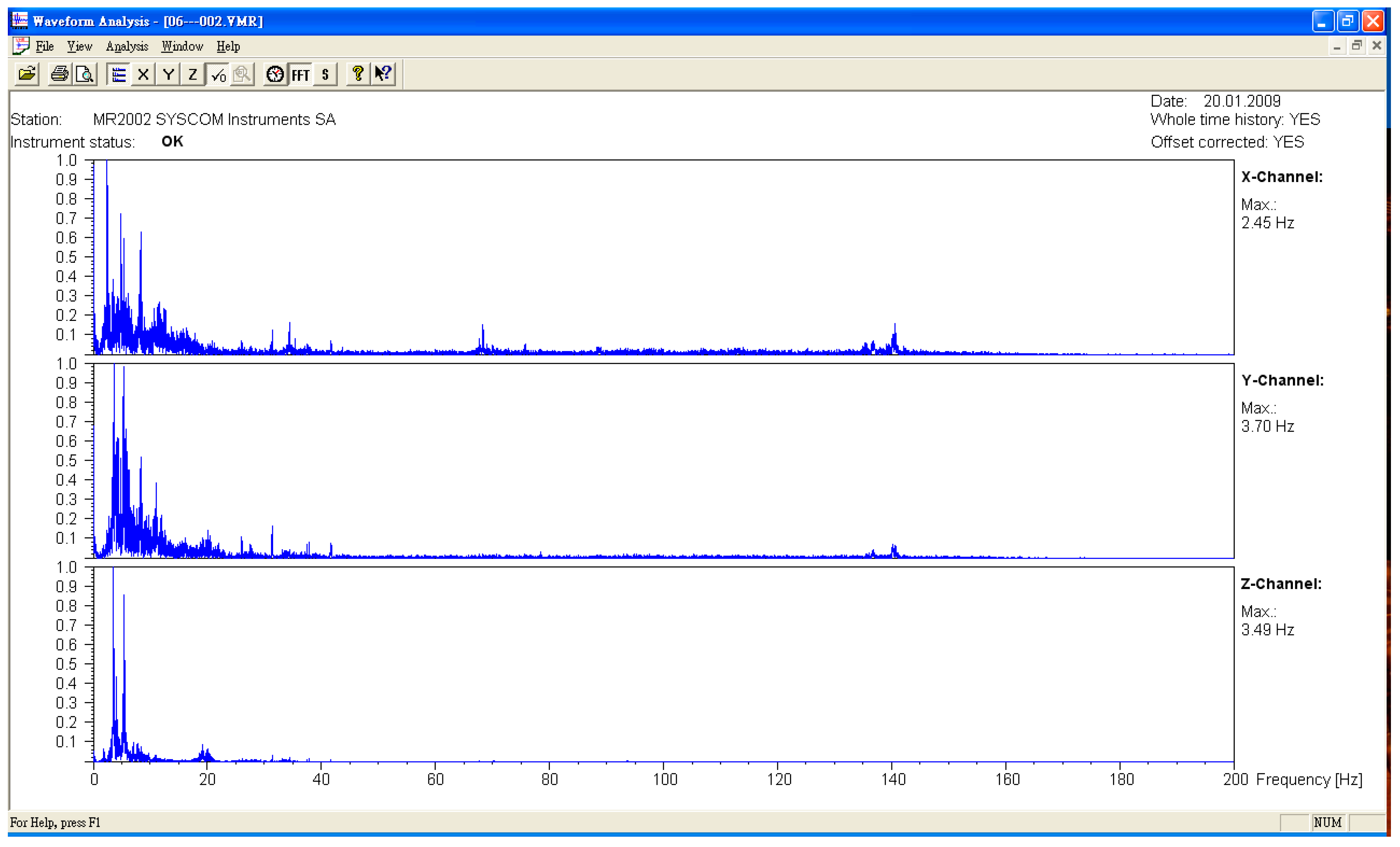


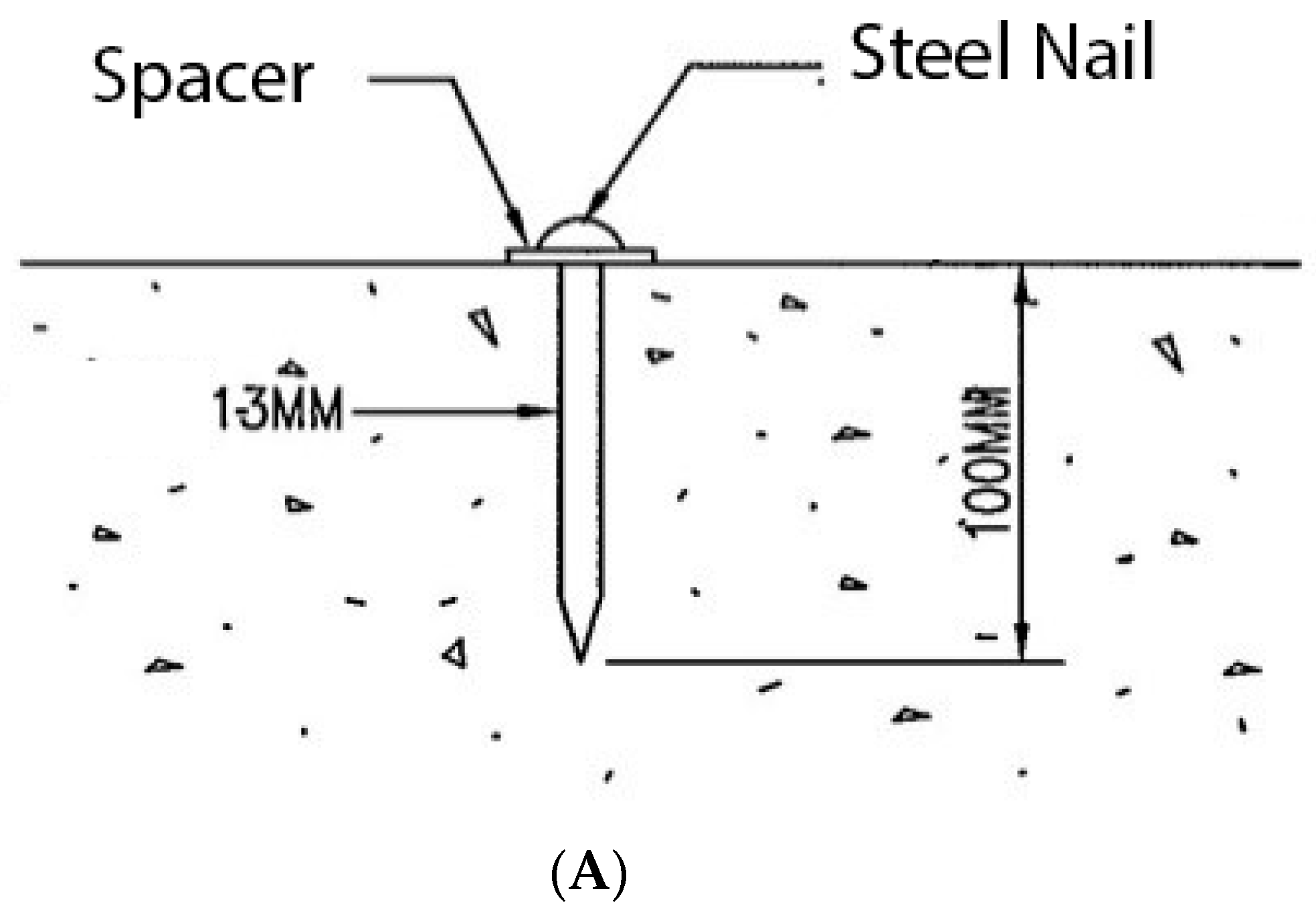





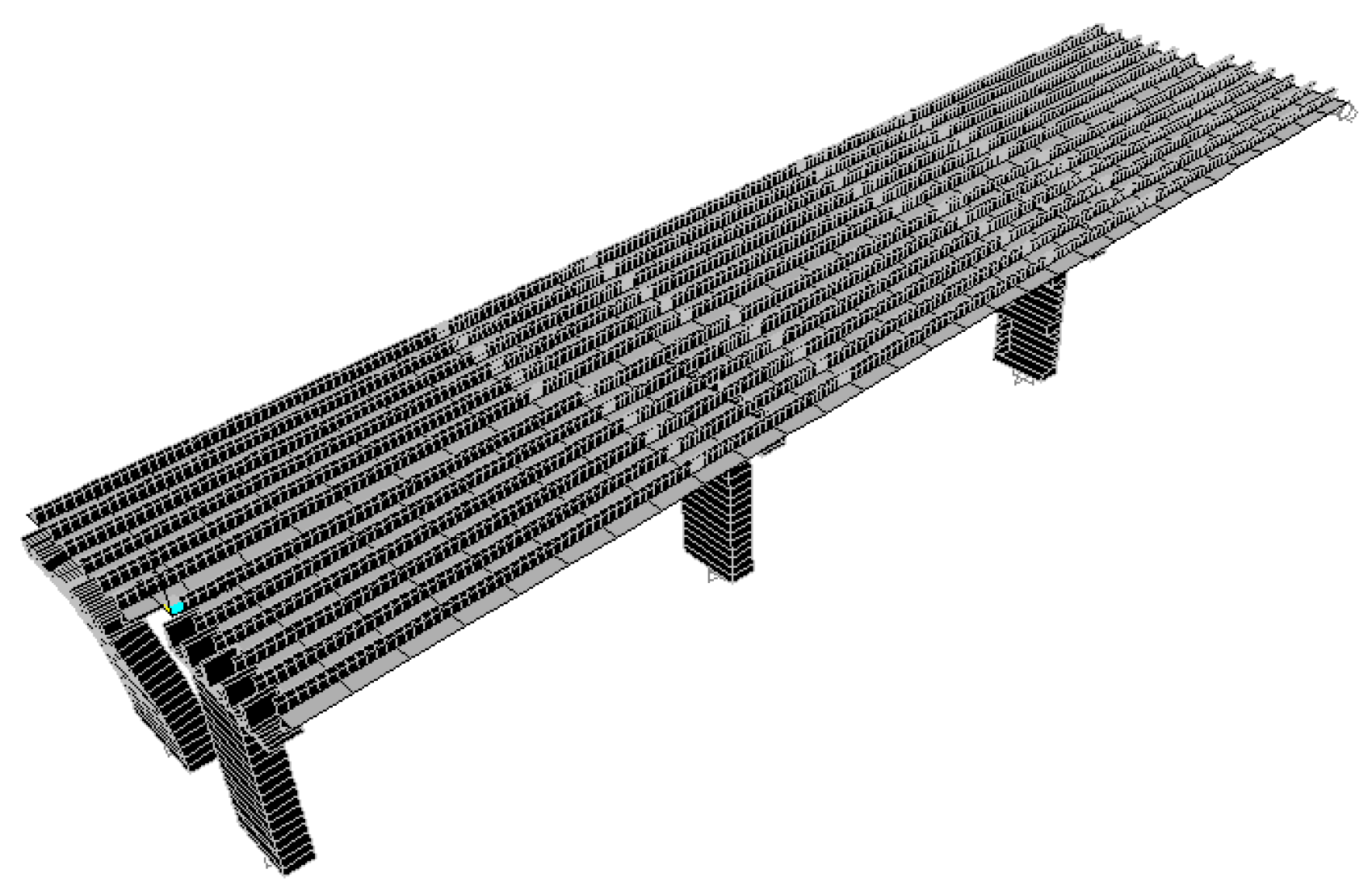
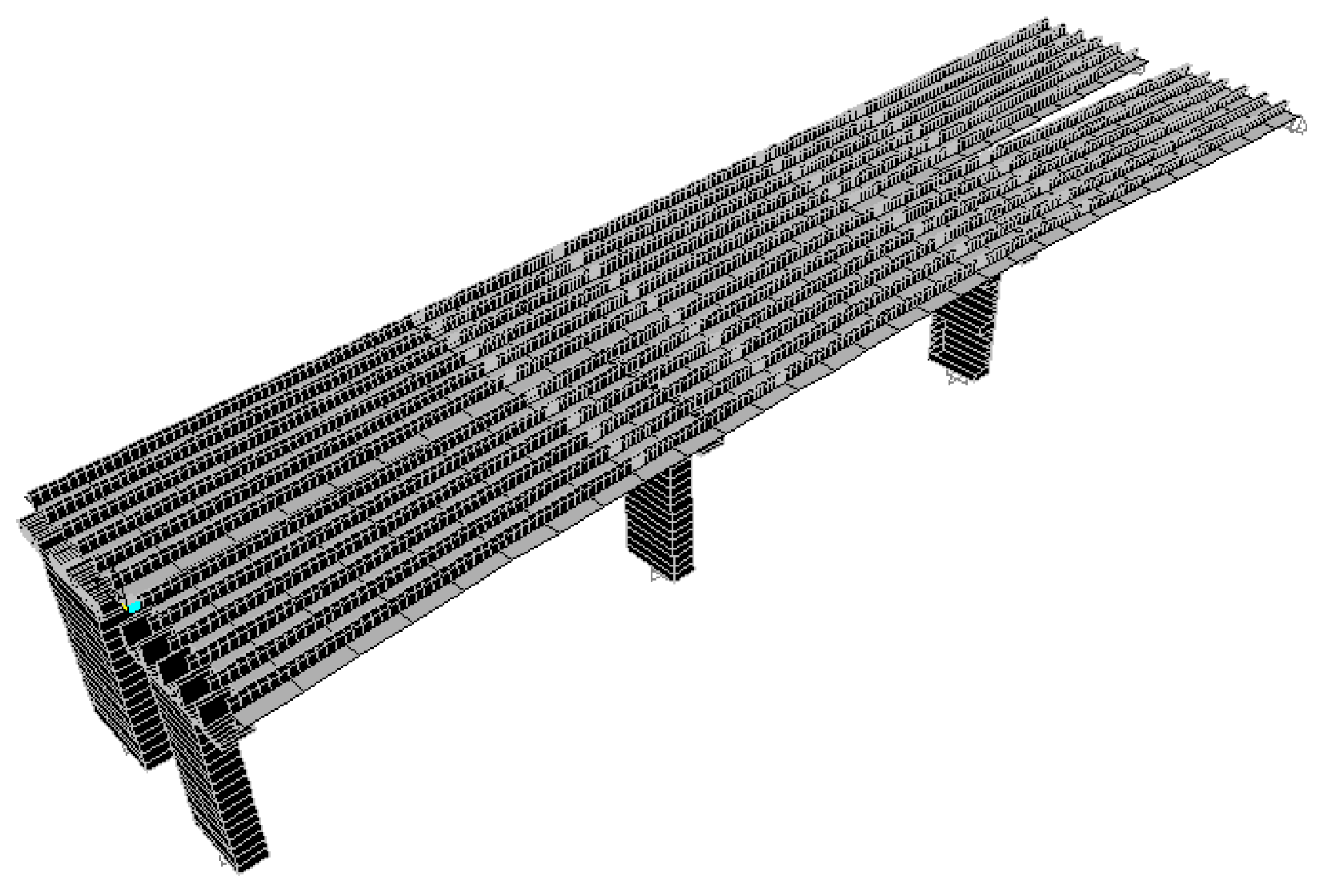




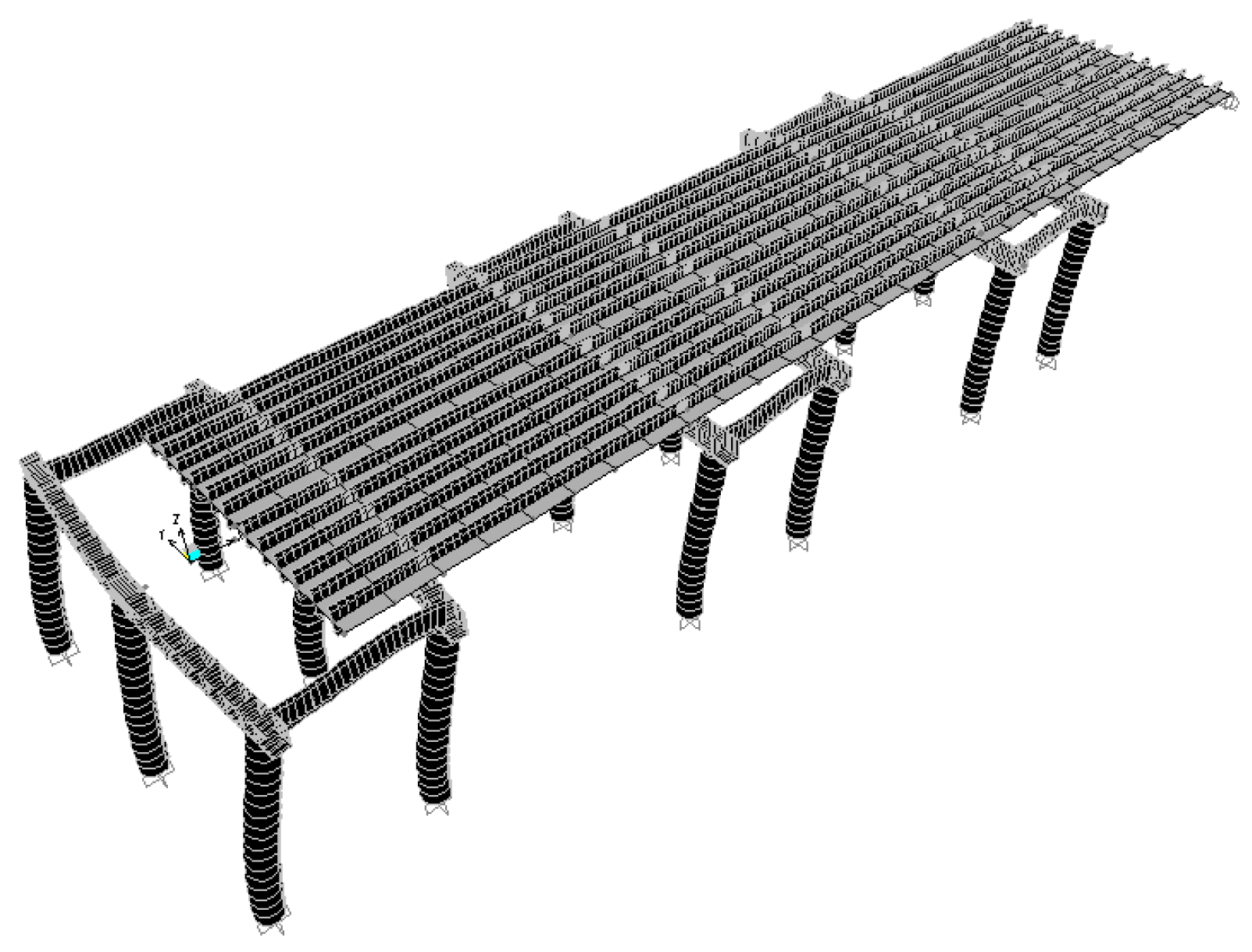

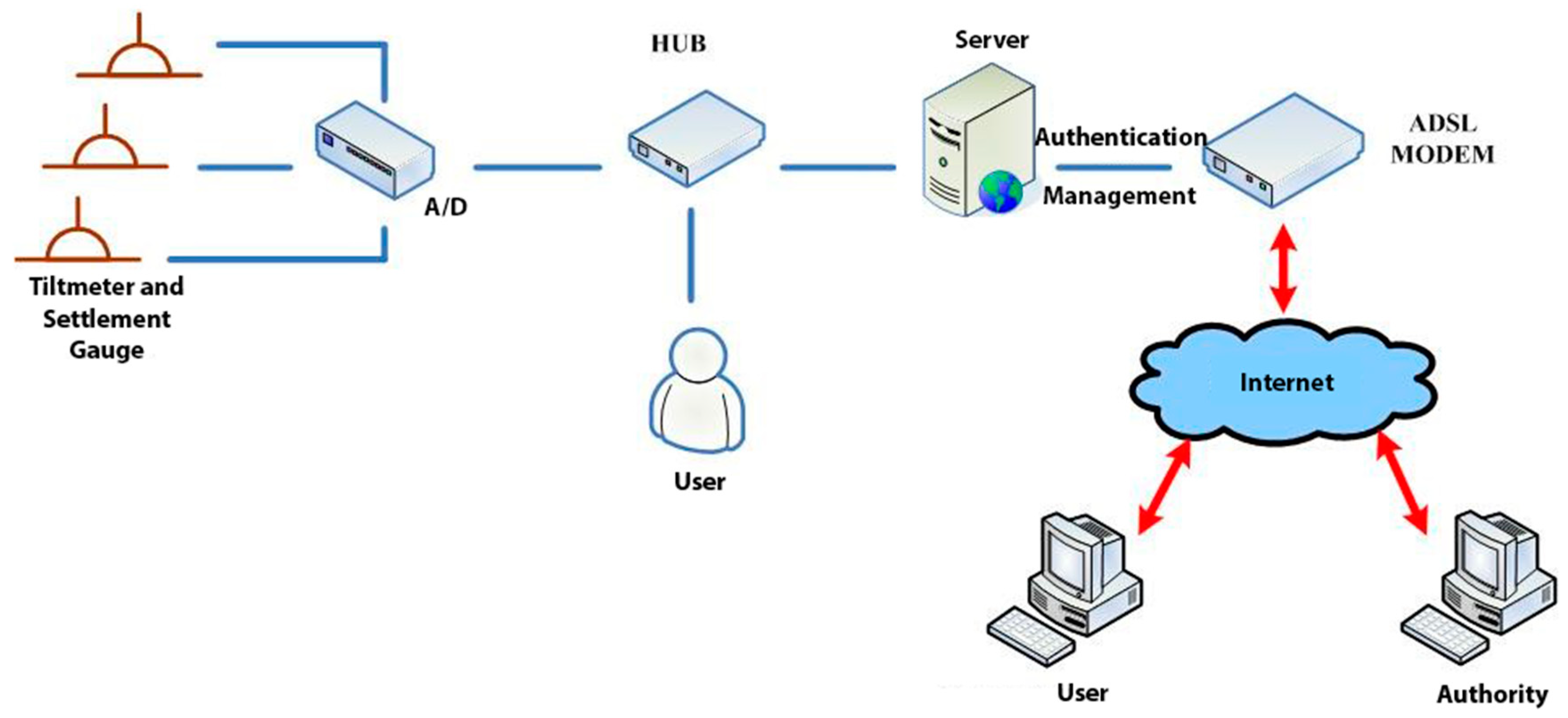
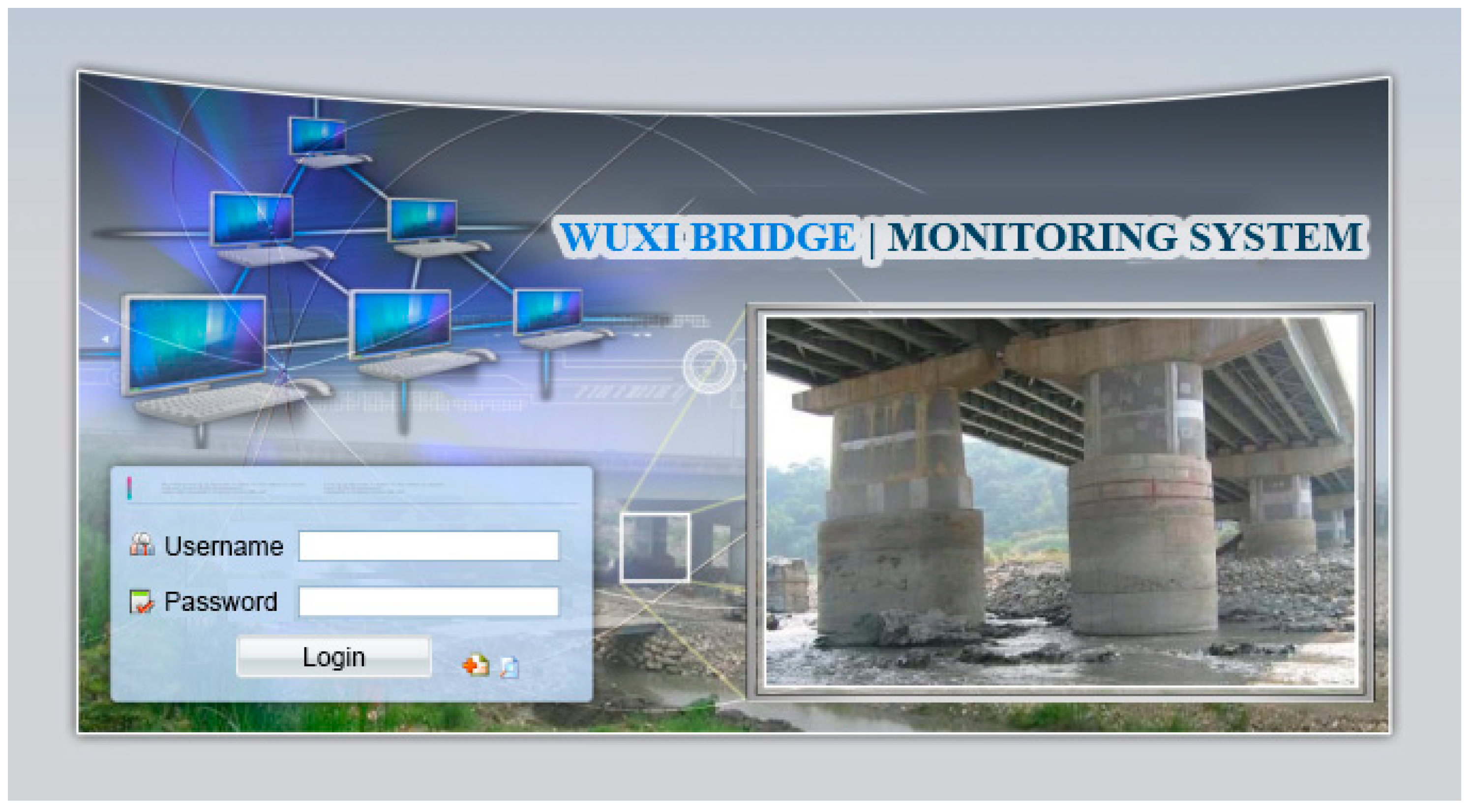

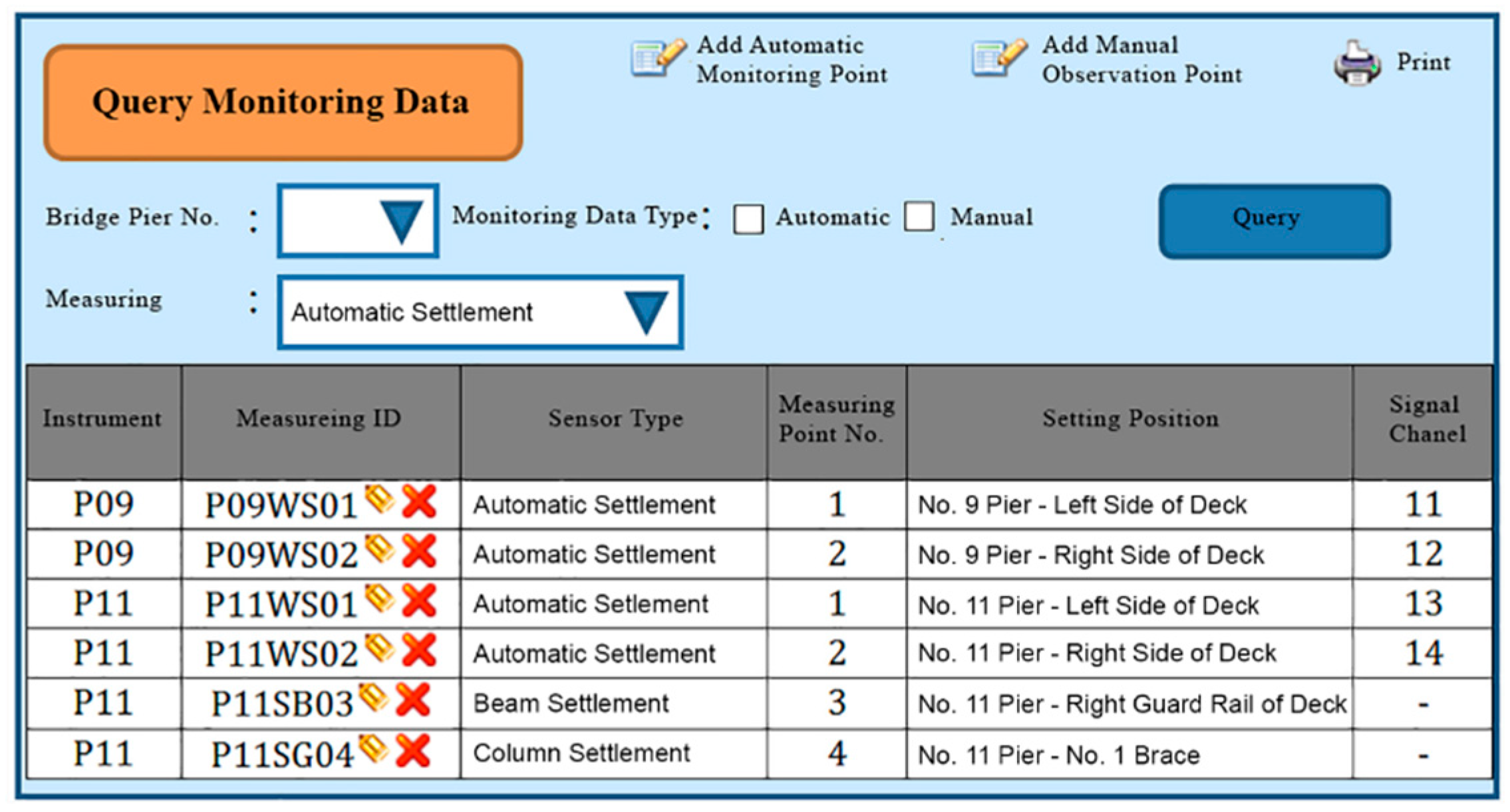


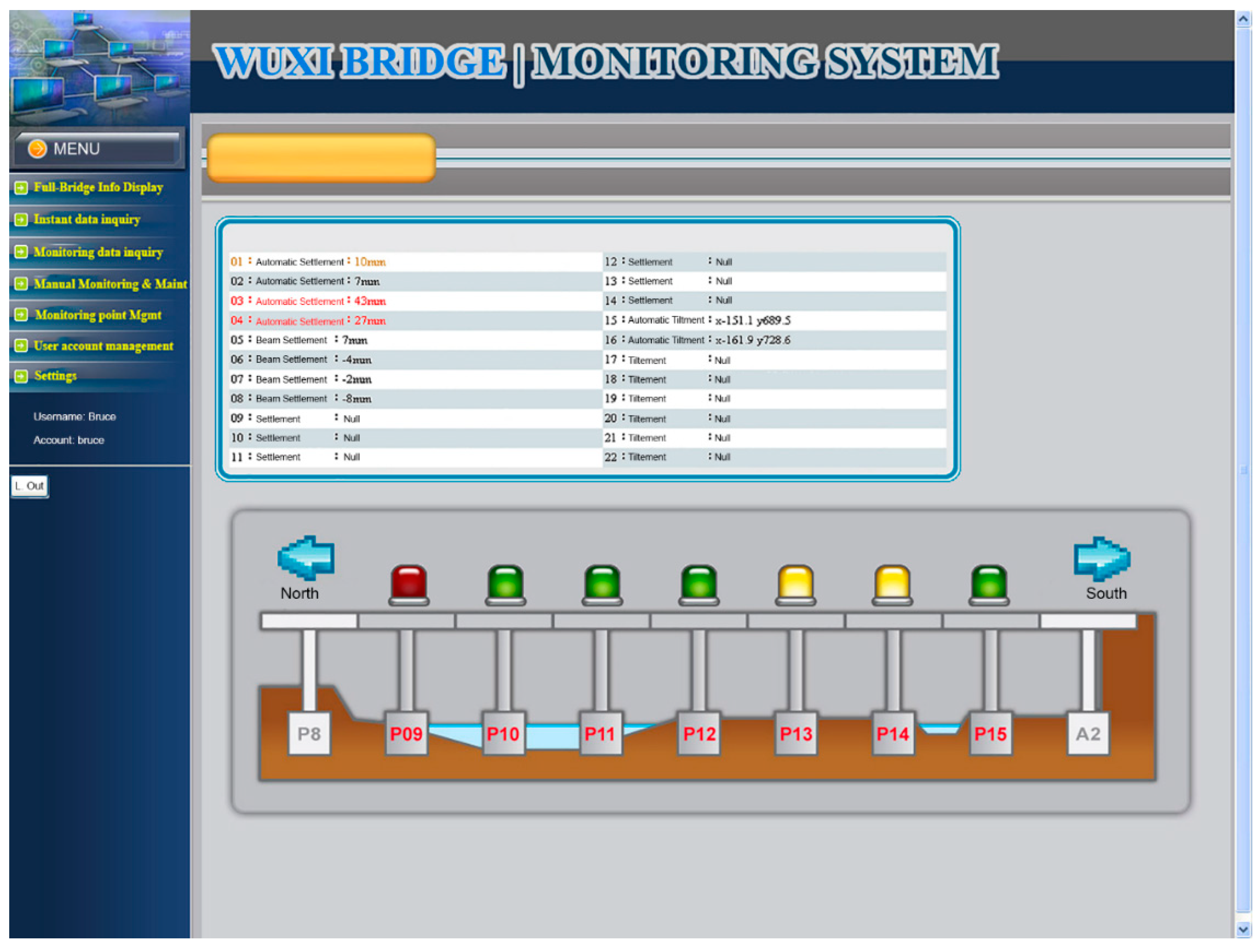
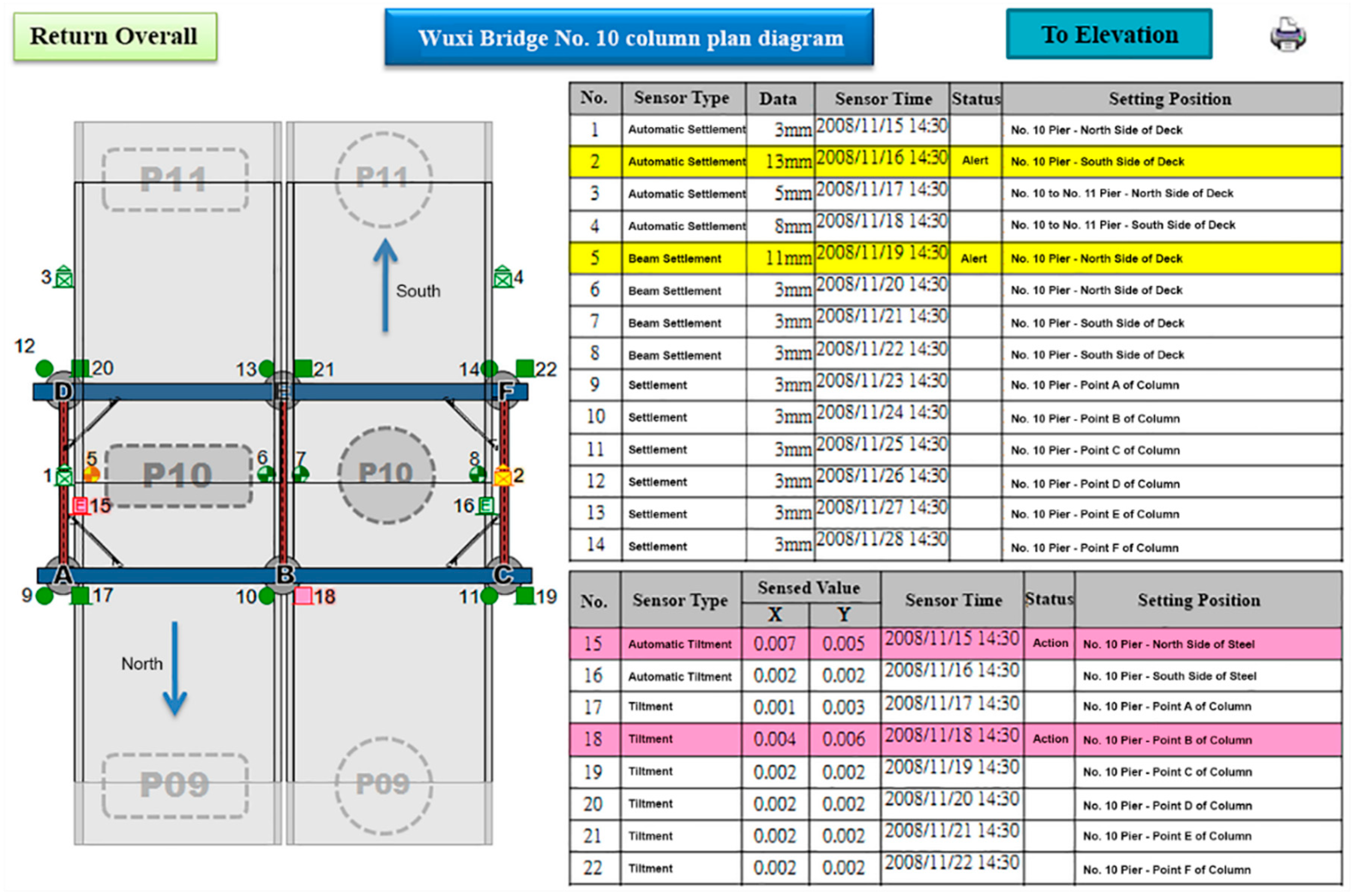
| Direction | X Axis | Y Axis | Z Axis | |||
|---|---|---|---|---|---|---|
| Driving Direction | Northbound | Southbound | Northbound | Southbound | Northbound | Southbound |
| Unit | Frequency (Hz) | Frequency (Hz) | Frequency (Hz) | Frequency (Hz) | Frequency (Hz) | Frequency (Hz) |
| P9 | ||||||
| Before jacking | 2.48 | 2.48 | 3.67 | 3.58 | 3.52 | 3.48 |
| After jacking | 2.53 | 2.48 | 2.87 | 2.81 | 6.08 | 6.34 |
| P10 | ||||||
| Before jacking | 2.45 | 2.43 | 3.41 | 3.65 | 3.47 | 3.47 |
| After jacking | 2.47 | 2.38 | 2.25 | 2.31 | 6.14 | 6.29 |
| P11 | ||||||
| Before jacking | 2.49 | 2.48 | 3.65 | 3.67 | 3.65 | 3.47 |
| After jacking | 2.48 | 2.31 | 3.59 | 1.88 | 5.07 | 5.35 |
© 2019 by the authors. Licensee MDPI, Basel, Switzerland. This article is an open access article distributed under the terms and conditions of the Creative Commons Attribution (CC BY) license (http://creativecommons.org/licenses/by/4.0/).
Share and Cite
Fang, Y.M.; Chou, T.Y.; Hoang, T.V.; Lee, B.J. Automatic Management and Monitoring of Bridge Lifting: A Method of Changing Engineering in Real-Time. Sensors 2019, 19, 5293. https://doi.org/10.3390/s19235293
Fang YM, Chou TY, Hoang TV, Lee BJ. Automatic Management and Monitoring of Bridge Lifting: A Method of Changing Engineering in Real-Time. Sensors. 2019; 19(23):5293. https://doi.org/10.3390/s19235293
Chicago/Turabian StyleFang, Yao Min, Tien Yin Chou, Thanh Van Hoang, and Bing Jean Lee. 2019. "Automatic Management and Monitoring of Bridge Lifting: A Method of Changing Engineering in Real-Time" Sensors 19, no. 23: 5293. https://doi.org/10.3390/s19235293






